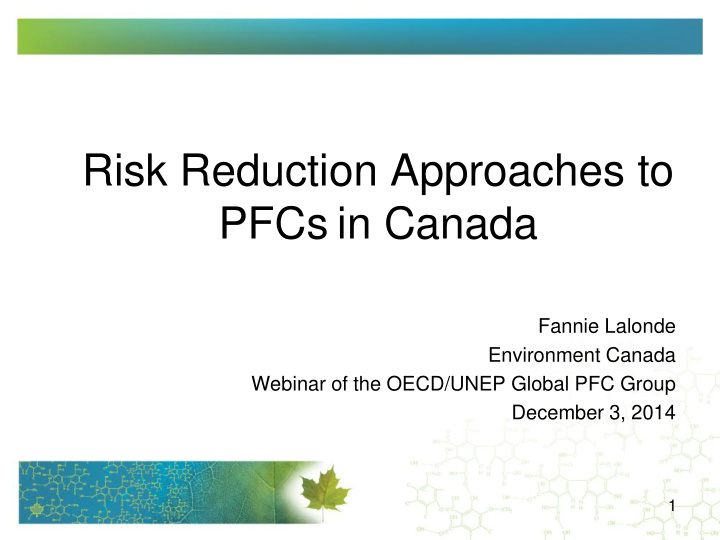



Risk Reduction Approaches to PFCs in Canada Fannie Lalonde Environment Canada Webinar of the OECD/UNEP Global PFC Group December 3, 2014 1
Perfluorinated carboxylic acids (PFCAs) • PFCAs are chains of carbon where the hydrogen atoms directly attached to the carbon atoms are all replaced with fluorine atoms. • Precursors to PFOA and LC-PFCAs are chemicals that degrade or breakdown to become PFOA or LC-PFCAs. Degrades or breaks down Fluorotelomer- PFCAs based substances 2
Four New Fluorotelomer-Based Substances • In 2004, the New Substances Program of Environment Canada and Health Canada assessed four new substances considered sources of PFCAs. These substances are all fluorotelomer based polymers. • The assessment concluded that these substances were toxic under the Canadian Environmental Protection Act, 1999 (CEPA, 1999), and met sections: – s.64( a ): “may enter the environment in a quantity or concentration or under conditions that have or may have an immediate or long-term harmful effect on the environment or its biological diversity" ; and – s.64(c) : "may enter the environment in a quantity or concentration or under conditions that constitute or may constitute a danger in Canada to human life or health." 3
Four New Fluorotelomer-Based Substances • Following the assessments of these four substances, the Ministers of Health and Environment imposed temporary prohibitions using the New Substances provisions of CEPA 1999. – Prohibition on manufacture and import – Four temporary Ministerial Prohibitions were published in the Canada Gazette, Part 1 (three on July 17, 2004, and a fourth on February 5, 2005) – Prohibitions under the New Substances provisions of CEPA 1999 expire after two years unless the Ministers propose a regulation to control the substances. • The four substances were added to the Prohibition of Certain Toxic Substances Regulations, 2012 – Prohibition on manufacture, use, sale, offer for sale and import, unless present in manufactured items. – Proposed regulations published in the Canada Gazette, Part 1 on June 17, 2006 – Final regulations published in the Canada Gazette, Part 2 on October 13, 2010. 4
Action Plan • In recognition that PFCAs and other precursor substances, similar to those four fluorotelomer-based substances, were already in commerce in Canada, the Action Plan for the Assessment and Management of PFCAs was published on June 17, 2006 • The Action Plan outlines measures for the assessment and management of PFCAs for Environment Canada and Health Canada. 5
Action Plan Commitments for PFOA and LC-PFCAs Measure Action Taken Date Maintain current approach of Publication of Regulations Amending the October 2010 prohibiting the introduction of Prohibition of Certain Toxic Substances new sources of PFCAs Regulations, 2005 (Four New Fluorotelomer- based Substances) Address sources already in Voluntary Performance Agreement March 2010 Canadian commerce respecting PFCAs signed with industry Pursue further assessment of Publication of Screening Assessment August 2012 PFCAs and precursors already Reports for PFOA , its salts and its in Canadian commerce precursors, and LC-PFCAs, their salts and their precursors Advance scientific understanding Implementation of a monitoring program Ongoing (Since of other possible sources (ecotoxicology, human exposure, 2006) environmental fate and distribution) Engage other regulatory Participation in the PFC Steering Group of Ongoing jurisdictions the OECD, and many workshops and conferences 6
Voluntary Agreement • A voluntary Environmental Performance Agreement respecting PFCAs and their precursors in perfluorochemical products sold in Canada was signed in March 2010 – Perfluorochemical products include fluroropolymers, fluoropolymer dispersions and fluorotelomer-based substances. They exclude end products and formulated items (i.e. paints, cleaners and surface treatments), the items they are applied to and manufactured items. • The agreement includes targets to reduce PFOA, LC-PFCAs and their precursors which are present in the form of residuals or impurities in perflurochemical products currently in commerce in Canada: – 95% reduction by December 31, 2010 – Elimination by December 31, 2015 • Participating companies have submitted baseline and annual reporting data • Reported data indicates that significant progress is being made in reaching the reduction targets 7
Screening Assessment Conclusions PFOA, its salts and precursors • Ecological Concern: found to have or may have an immediate or long-term harmful effect on the environment or its biological diversity (meets s. 64(a) criteria). Also found to be persistent, according to the Persistence and Bioaccumulation Regulations, 2000, and bioaccumulative based on weight of evidence. • Not found to be a health concern at current exposure levels. Long-chain PFCAs, their salts and precursors • Ecological Concern: found to have or may have an immediate or long-term harmful effect on the environment or its biological diversity (meets s. 64(a) criteria). Also found to be persistent, according to the Persistence and Bioaccumulation Regulations, 2000, and bioaccumulative based on weight of evidence. • Health Assessment has not yet been completed for LC-PFCAs. 8
Proposed Risk Management • The Government of Canada published a document on the proposed risk management approach for PFOA and LC-PFCAs for a 60-day public comment period (August 2012) – The document proposed to prohibit PFOA and LC-PFCA through regulations • A consultation document on the proposed risk management measure for PFOA and LC-PFCA was published for a 30-day public comment period (January 2014) – The document proposed to add PFOA and LC-PFCAs to the Prohibition of Certain Toxic Substances Regulations, 2012 – The Regulations would prohibit the manufacture, use, sale, offer for sale and import of PFOA and LC-PFCAs, unless present in manufactured items – Accommodations (permitted uses, temporary permitted uses, concentration limits) will be considered – Additional risk management measures to prohibit these substances from manufactured items may be considered in the future 9
Upcoming and Ongoing Activities • Pending publication of the proposed Amendments to the Prohibition of Certain Toxic Substances Regulations • Continued work on the Environmental Performance Agreement for PFCAs (final report year: 2015) • Ongoing engagement and cooperation with other countries 10
Information Sources • Four new fluorotelomer-based substances: http://www.ec.gc.ca/toxiques- toxics/Default.asp?lang=En&n=0593FBA5-1 • PFOA and LC-PFCAs: http://www.ec.gc.ca/toxiques- toxics/Default.asp?lang=En&n=6B9B6B28- 1&xml=F68CBFF1-B480-4348-903D- 24DFF9D623DC 11
Contact Information Fannie Lalonde Risk Management, Persistent Organic Pollutants Section Environment Canada fannie.lalonde@ec.gc.ca 12
Recommend
More recommend